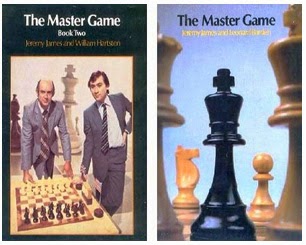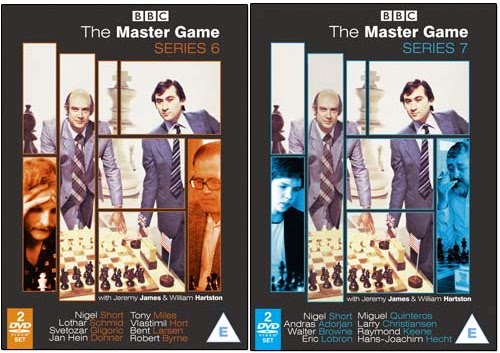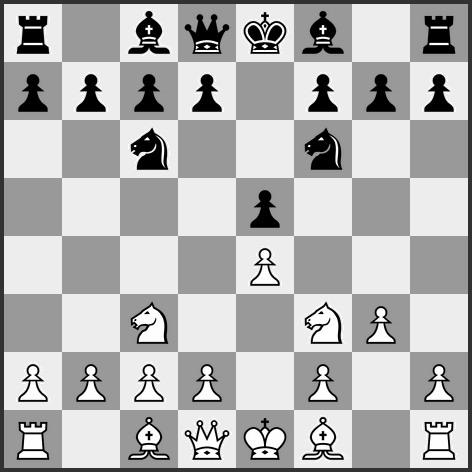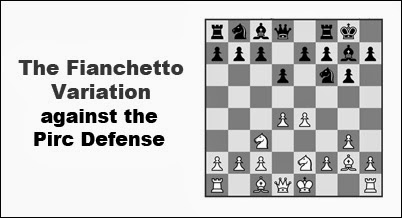The Master Game chess program from the BBC has been issued on DVD in response to online interest, including lobbying by bloggers like Mark Weeks and the obvious consumer interest in the program evidenced by many popular copyright infringements on YouTube. I have compiled PGN files of the games in Series 1-7 and information for purchasing DVDs and books below.
The Master Game was the first program to show chess on television in a way that had a chance of connecting with the larger chess-playing public. As producer Robert Toner notes:
I had seen many forms of television chess coverage, but none of them was satisfactory. Pieces would disappear from one square and appear in another, and only experts seemed to be able to follow a game. Also, it was all so remote, I felt no involvement with the game or the players. What we needed was direct access into their thoughts, not the high-speed technical thoughts of a chess-playing mind, but thoughts put in such a way that anyone who knew the rules would be able to follow the most complicated game. (Foreword, The Master Game, 1979)The system Toner developed had players compete in a knock-out tournament at a BBC studio, where the games themselves were recorded; then, about two days later, the players recreated their thoughts during the game in a sound studio. The games were played under tournament conditions, with forty moves in two-and-a-half hours followed by an hour sudden death. (In the first three series, with absolute knockout format, there were also rules for replaying drawn games, but in later tournaments the rules were changed to avoid replays.) The game play was edited to a 30-minute program, so the audience did not have to endure long and unpredictable delays between moves, and commentary by the players was added.
What made the program so successful was the fiction that the players were commenting on the games as they were happening, with the comments always expressed in present-tense form, thus creating a sense of engagement and immediacy that is not achieved in other formats, except perhaps in the now ubiquitous videos where players comment on their blitz games while in progress. The types of comments offered by the players were also quite effective at communicating the way GMs usually choose a move, relying more on chess reasoning and intuition than the calculation of long variations, except where the position called for that. Though we now have access to a lot of chess on video, no one seems to have invested the time and resources to create a similar product, though Maurice Ashley's Speed Chess DVD comes close, substituting exciting play-by-play commentary for the players' own thoughts.
Besides serving as excellent instructional videos, these DVDs are worth having for the living history they contain. Where else are you going to find the great players of the 70s and 80s commenting on their games? The Series 7 DVD also contains a bonus documentary feature about Matthew Sadler titled "The Lowdown: The Master of the Game" (1989). Highly recommended.
Purchase DVDs
The videos can be purchased directly from Odeon Entertainment as DVDs or digital downloads. So far they have re-issued Series 6 and Series 7, which can also be purchased from New in Chess, Chess & Bridge and other European online re-sellers. I have not been able to identify a U.S. distributor, but I had no trouble ordering from New in Chess, which always provides excellent service. One important note: the DVDs are "Region 0" and PAL format, so they will not play on older DVD players made for the U.S. market. I have a ten-year-old DVD player on which they do not play, but they do work on my computer's DVD player with no problem.
BBC: The Master Game Series 6. Contains all 13 30-minute programs for a total of 390 minutes on two DVDs, featuring Bent Larsen, Nigel Short, Svetozar Gligoric, Vlastimil Hort, Robert Byrne, Tony Miles, Lothar Schmid and Jan Hein Donner.
BBC: The Master Game Series 7. Contains all 13 30-minute programs for a total of 390 minutes on two DVDs, featuring Andras Adorjan, Nigel Short, Walter Browne, Eric Lobron, Raymond Keene, Larry Christiansen, Miguel Quinteros and Hans-Joachim Hecht.
Games and PGN File Downloads
I have annotated one of the better games in "How Passed Pawns Win 'Master Games'" on this blog, which includes several passed pawn puzzles from the series. I have also collected all of the games played in the Master Game tournaments and posted them as separate PGN files for download or Java replay:
Series 1 - 1975 (PGN) (Java replay)
Series 2 - 1976 (PGN) (Java replay)
Series 3 - 1977 (PGN) (Java replay)
Series 4 - 1979 (PGN) (Java replay)
Series 5 - 1980 (PGN) (Java replay)
Series 6 - 1981 (PGN) (Java replay)
Series 7 - 1982 (PGN) (Java replay)
Special thanks to Tom Martinak from the Pitt Chess Archives for supplying me with the PGN files from the first three series, which saved me a lot of trouble compiling them by hand. The Pitt Archives were taken down due to security concerns over their FTP hosting, but I understand they will eventually be available again when a new host is chosen. I found PGN files of other games at 365chess and Chessgames.com, and some games I added by hand from the books (see below). I have followed the books for game order and moves where sources disagreed. Unfortunately, only very late in my research did I discover Mark Weeks's excellent zipped PGN of the games, which saved me from having to compile Series 6 by hand. I think the files are now complete, but I welcome corrections and additions if I have overlooked anything.
Books
 |
| The copies of the books I own are wider than represented. |
The Master Game by Jeremy James and Leonard Barden, British Broadcasting Corporation (1979). Contains all of the games from the first three series (1975, 1976, and 1977), with a foreword by producer Robert Toner, biographies of the players in each series, and the 36 annotated games (with notes drawing from the GM commentary on the show), plus opening and player indexes. In algebraic notation. This is a very attractive and well edited book.
The Master Game, Book Two by Jeremy James and William Hartston, British Broadcasting Corporation (1981). Contains 41 annotated games from Series 4, 5, and 6 (1979, 1980, and 1981), plus the game scores from the first three series. Like the first volume, it has biographies of players and indexes.
Videos Online
There have been a number of people posting The Master Game videos online, but most have been taken down recently as the publisher has moved to protect the copyright in anticipation of re-issuing them on DVD. Only the first two videos below are official trailers, so the others may vanish at any time.
Links
- The Master Game at Wikipedia
- Chess for All Ages on The Master Game by Mark Weeks
- Mark Weeks PGN Zip
- BBC: The Master Game revived on DVD, ChessBase (July 2, 2013)
- The Master Game by Jonathan Berger
- BBC's The Mater Game on YouTube by Peter Doggers
- BBC Master Game Series 1 by RedShield at Chessgames.com
- BBC Master Game Series 2 by RedShield at Chessgames.com
- BBC Master Game Series 3 by RedShield at Chessgames.com
- BBC Master Game Series 4 by RedShield at Chessgames.com
- London BBC TV 1975 at 365chess
- London BBC TV-B 1979 at 365chess
- London BBC TV-A 1979 at 365chess
- London BBC TV-final 1979 at 365chess
- London BBC TV-A 1981 at 365chess











